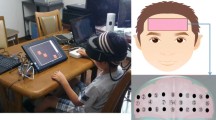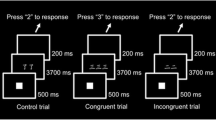Abstract
Despite the implication of fronto-striatal circuits in attention-deficit/hyperactivity disorder (ADHD), there is a lack of information on the role of these regions, especially the thalamus, in the heterogeneity of ADHD. We assessed the 1H-magnetic resonance spectroscopy profile in ventromedial prefrontal cortex (VMPFC)-thalamic-striatal regions bilaterally in three groups of subjects (age range 18–24 years old): ADHD inattentive type (ADHD-I; n = 9), ADHD combined type (ADHD-C; n = 10) and non-ADHD controls (n = 12). The peaks of N-acetylaspartate, Choline (Cho), myo-inositol (mI), creatine (Cr) and glutamate-glutamine-GABA (Glx) to Cr were calculated. Subjects with ADHD-C showed lower mI/Cr ratio in the right VMPFC than controls, higher Cho/Cr ratio in the left thalamus-pulvinar than the ADHD-I group and higher Glx/Cr ratio in left putamen than individuals with ADHD-I and controls. This metabolic profile suggests a disruption of fronto-striato-thalamic structures in the ADHD-C as a result of lower neuronal energetic metabolism.


Similar content being viewed by others
References
American Psychiatric Association (1994) Diagnostic and statistical manual of mental diseases, 4th edn (DSM-IV). American Psychiatric Association, Washington, DC
Barkley RA (1997) Behavioral inhibition, sustained attention, and executive functions: constructing a unifying theory of ADHD. Psychol Bull 121:65–94
Barkley RA, Grodzinsky G, DuPaul GJ (1992) Frontal lobe functions in attention disorder with and without hyperactivity: a review and research report. J Abnorm Child Psychol 20:163–188
Carrey N, MacMaster FP, Sparkes SJ, Khan SC, Kusumakar V (2002) Glutamatergic changes with treatment in attention deficit hyperactivity disorder: a preliminary case series. J Child Adolesc Psychopharmacol 12:331–336
Carrey N, MacMaster FP, Fogel J, Sparkes SJ, Waschbusch D, Sullivan S et al (2003) Metabolite changes resulting from treatment in children with ADHD: a 1H-MRS study. Neuropharmacology 26:218–221
Casey BJ, Castellanos FX, Giedo JN, Marsh WL, Hamburger SD, Schubert AB, Vayss YC, Vaituzis AC, Dickstein DP, Sarfatti SE, Rapoport JL (1997) Implication of right frontostriatal circuitry in response inhibition and attention-deficit/hyperactivity disorder. J Am Acad Child Adolesc Psychiatry 36:374–383
Courvoisie H, Stephen R, Hooper SR, Fine C, Kwock L, Castillo M (2004) Neurometabolic functioning and neuropsychological correlates in children with ADHD-H: preliminary findings. J Neuropsychiatry Clin Neurosci 16:63–69
Deicken RF, Johnson C, Pegues M (2000) Proton magnetic resonance spectroscopy of human brain in schizophrenia. Rev Neurosci 304:117–119
Faraone SV, Biederman J, Weber W, Russel R (1998) Psychiatric, neuropsychological, and psychosocial features of DSM-IV subtypes of attention deficit hyperactivity d: results from a clinically referred sample. J Am Acad Child Adolesc Psychiatry 37:185–189
Fayed N, Modrego PJ (2005) Comparative study of cerebral white matter in autism and attention-deficit/hyperactivity disorder by means of magnetic resonance spectroscopy. Acad Radiol 12:566–569
Fayed N, Modrego PJ, Castillo J, Dávilla J (2007) Evidence of brain dysfunction in attention deficit-hyperactivity disorder: a controlled study with proton magnetic resonance spectroscopy. Acad Radiol 14:1029–1035
First MB, Spitzer RL, Gibbon M, Williams JB (1998) Structured clinical interview for DSM-IV axis I. Disorders, patient edition (SCID-I/P, Version 2.0, 8/98 revision). Biometric Research Department, New York State Psychiatric Institute, New York
Grevet EH, Bau CHD, Salgado CAI, Fisher AG, Victor MM, Garcia C, Sousa NO, Nerung L, Belmonte-de-Abreu P (2005) Interrater reliability for diagnosis in adults of attention-deficit/hyperactivity disorder and oppositional defiant disorder using K-SADS-E. Arq Neuropsiquiatr 63:307–310
Hesslinger B, Thiel T, Elst LT, Henning J, Ebert D (2001) Attention-deficit disorder in adults with or without hyperactivity: where is the difference? A study in humans using short echo 1H-magnetic resonance spectroscopy. Neurosci Lett 304:117–119
Jin Z, Zang YF, Zeng YW, Zhang L, Wang YF (2001) Striatal neuronal loss or dysfunction and choline rise in children with attention-deficit hyperactivity disorders: a 1H-magnetic resonance spectroscopy study. Neurosci Lett 315:45–48
Larsson H, Lichtenstein P, Larsson J-O (2006) Genetic contributions to the development of ADHD subtypes from childhood to adolescence. J Am Acad Child Adolesc Psychiatry 45:973–981
MacMaster FP, Carrey N, Sparkes S, Kusumakar V (2003) Proton spectroscopy in medication-free pediatric attention-deficit/hyperactivity disorder. Biol Psychiatry 15:184–187
Malhi GS, Valenzuela M, Wen W, Sachdev P (2002) Magnetic resonance spectroscopy and its applications in psychiatry. Aust NZ J Psychiatry 36:31–43
Mattos P, Serra-Pinheiro MA, Rohde LA, Pinto D (2006) Apresentação de uma versão em português para uso no Brasil do instrumento MTA-SNAP-IV de avaliação de sintomas de transtorno de déficit de atenção / hiperatividade e sintomas de transtorno desafiador e de oposição. Rev Psiquiatr Rio Gd Sul 28:290–297
McBurnett K, Pfeiffener LJ, Willcut E, Tam L, Lerner M, Ottolini YL, Furman MB (1999) Experimental cross-validation of DSM-IV types of attention-deficit/hyperactivity disorder. J Am Acad Child Adolesc Psychiatry 38:17–24
Mercadante MT, Asbahar F, Rosário MC, Ayres AM, Karman L, Ferrari MC, Assumpção FB, Miguel EC (1995) K-SADS, entrevista semi-estruturada para diagnóstico em psiquiatria da infância, versão epidemiológica. FMUSP, São Paulo
Moffetti JR, Tieman SB, Weinberg DR, Coyle JT, Namboodiri AMA (2006) N-acetylaspartate—a unique neuronal molecule in the central nervous system. Advances in experimental medicine and biology, vol 576. Springer Science + Business Media Inc., Heidelberg, pp 7–26
Moore CM, Breeze JL, Gruber SA, Babb SM, Frederick BB, Villafuerte RA, Stoll AL, Hennen J, Yurgelun-Todd DA, Cohen BM, Renshaw PF (2000) Choline, myo-inositol and mood in bipolar disorder: a proton magnetic resonance spectroscopy imaging study of anterior cingulated cortex. Bipolar Disord 2:207–216
Moore CM, Biederman J, Wozniak J, Mick E, Aleardi M, Wardrop M, Dougherty M, Harpold T, Hammerness P, Randall E, Renshaw P (2006) Differences in brain chemistry in children and adolescents with attention deficit hyperactivity disorder with and without comorbid bipolar disorder: a proton magnetic resonance spectroscopy study. Am J Psychiatry 163:316–318
Pliszka ER, McCracken JT, Mass JW (1996) Catecholamines in attention-deficit hyperactivity disorder: current perspectives. J Am Acad Child Adolesc Psychiatry 35:264–271
Polanczyk G, Rohde LA (2007) Epidemiology of attention-deficit/hyperactivity disorder across the lifespan. Curr Opin Psychiatry 20:386–392
Polanczyk G, Horta B, Lima M, Biederman J, Rohde LA (2007) The worldwide prevalence of attention-deficit hyperactivity disorder: a systematic review and meta-regression analysis. Am J Psychiatry 164:942–948
Provencher SW (1993) Estimation of metabolite concentrations from in vivo proton NMR spectra. Magn Reson Med 30:672–679
Rohde LA (2008) Is there a need to reformulate attention deficit hyperactivity disorder criteria in future nosologic classification? Child Adolesc Psychiatr Clin N Am 17:405–420
Rohde LA, Biederman J, Busnello EA, Zimmermann H, Schmitz M, Martins S, Tramontina S (1999) ADHD in a school sample of Brazilian adolescents: a study of prevalence, comorbid conditions, and impairments. J Am Acad Child Adolesc Psychiatry 38:716–722
Rubia K, Smith AB, Brammer MJ, Toone B, Taylor E (2005) Abnormal brain activation during inhibition and error detection in medication-naïve adolescents with ADHD. Am J Psychiatry 162:1067–1075
Russell VA, Oades RD, Tannock R, Killeen PR, Auerbach JG, Johansen EB et al (2006) Response variability in attention-deficit/hyperactivity disorder: a neuronal and glial energetics hypothesis. Behav Brain Funct 2:30
Schmitz M, Cadore L, Paczko M, Kipper L, Chaves M, Rohde LA, Moura C, Knijnik M (2002) Neuropsychological performance in DSM-IV ADHD subtypes: an exploratory study with untreated adolescents. Can J Psychiatry 47:863–869
Schmitz M, Denardin D, Silva TL, Pianca T, Hutz M, Faraone S, Rohde LA (2006a) Smoking during pregnancy and ADHD inattentive type: a case-control study. J Am Acad Child Adolesc Psychiatry 45:1338–1345
Schmitz M, Denardin D, Silva TL, Pianca T, Hutz M, Faraone S, Rohde LA (2006b) Association between alpha-2a-adrenergic receptor gene and ADHD inattentive type. Biol Psychiatry 60:1028–1033
Sun L, Jin Z, Zang Y, Zeng Y, Liu G, Seidman LJ, Faraone S, Wang Y (2005) Differences between attention-deficit disorder with and without hyperactivity: a 1H-magnetic resonance spectroscopy study. Brain Dev 27:340–344
Swanson JM, Kraemer HC, Hinshaw SP, Arnold LE, Conners CK, Abikoff HB (2001) Clinical relevance of primary findings of the MTA: success rates base don severity of ADHD and ODD symptoms at the end of treatment. J Am Acad Child Adolesc Psychiatry 40:168–179
Todd RD, Botteron KN (2001) Is attention-deficit/hyperactivity disorder an energy deficit syndrome? Biol Psychiatry 50:151–158
Woo BS, Rey JM (2005) The validity of the DSM-IV subtypes of attention-deficit/hyperactivity disorder. Aust NZ J Psychiatry 39:344–353
Conflict of interest statement
Dr Rohde was on the speaker’s bureau and/or acted as consultant for Eli-Lilly, Janssen-Cilag, and Novartis in the last three years. Currently, his only industry related activity is taking part in the advisory board/speaker’s bureau for Eli Lilly and Novartis (less than U$ 10,000 per year and reflecting less than 5% of his gross income per year). The ADHD and Juvenile Bipolar Disorder Outpatient Programs chaired by him received unrestricted educational and research support from the following pharmaceutical companies in the last three years: Abbott, Bristol-Myers Squibb, Eli-Lilly, Janssen-Cilag, and Novartis. Dr Palmini is on the speaker’s bureau or is a consultant for Janssen-Cilag and Novartis. Dr Abreu is on the speaker’s bureau or is a consultant for Janssen-Cilag and Bristol-Myers Squibb. Dr Grevet is on the speaker’s bureau or is a consultant for Novartis and Janssen-Cilag.
Author information
Authors and Affiliations
Corresponding author
Rights and permissions
About this article
Cite this article
Ferreira, P.E.M.S., Palmini, A., Bau, C.H.D. et al. Differentiating attention-deficit/hyperactivity disorder inattentive and combined types: a 1H-magnetic resonance spectroscopy study of fronto-striato-thalamic regions. J Neural Transm 116, 623–629 (2009). https://doi.org/10.1007/s00702-009-0191-3
Received:
Accepted:
Published:
Issue Date:
DOI: https://doi.org/10.1007/s00702-009-0191-3




